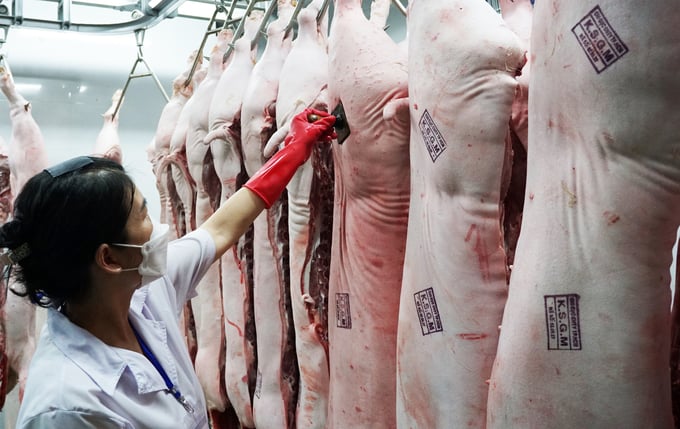November 26, 2025 | 00:16 GMT +7
November 26, 2025 | 00:16 GMT +7
Hotline: 0913.378.918
November 26, 2025 | 00:16 GMT +7
Hotline: 0913.378.918
According to the Department of Animal Health, there are 463 concentrated animal slaughterhouses in the whole country, including 246 pig slaughterhouses. The concentrated animal slaughterhouses that have been granted the Certificate of eligibility for veterinary hygiene/food safety are all controlled by veterinary staff. This is to control slaughter according to regulations. The number of pigs under control slaughtered according to regulations at the concentrated animal slaughterhouses in 2022 is over 11.5 million pigs. In the first 5 months of 2023, the number is over 8.6 million heads.

Strengthening control and concentrating slaughter will contribute to effective disease prevention and control.
It is worth mentioning that the whole country currently has over 24,600 small-sized animal slaughterhouses, of which over 17,600 are pig slaughterhouses. The number of pigs that are under control slaughtered according to regulations at small-scale slaughter facilities in 2022 is over 8.6 million pigs. In the first 5 months of 2023, the number of pigs is over 8.5 million heads.
According to the Department of Animal Health, in mountainous provinces, the practice of small-scale and scattered husbandry is the majority, leading to a large number of small-scale slaughtering households in residential areas. While traffic is difficult, small-scale slaughter facilities are widely distributed in the districts. Slaughtering is dispersed, so the inspection and control of slaughterhouses face many difficulties due to insufficient resources. Veterinary agencies only control about 18.6% of the small number of small-scale slaughterhouses in the area; some localities do not implement slaughter control.
In some localities, slaughtering activities take place spontaneously, many small-scale slaughterhouses do not meet the requirements of veterinary hygiene and food safety. The local authorities have not paid attention to the management and supervision. The District Agricultural Service Center and the commune-level government are assigned to manage small and medium-sized slaughter control. However, there is a shortage of staff with veterinary expertise to carry out slaughter control. Illegal and foul slaughter that has not been dealt with decisively and completely in the area is still common in many localities.
The people's awareness of complying with veterinary laws on slaughter is not high; The understanding of food safety, and disease safety to meet the slaughtering conditions and suitable investment of small-scale slaughterhouse owners is still limited; Many small-scale slaughterhouses slaughter and sell them at home, on sidewalks..., making it difficult to properly and fully implement the process of slaughter control and veterinary hygiene inspection.
In animal quarantine, slaughter control, and veterinary hygiene inspection in the localities merged The district-level veterinary specialized management station into an Agricultural Service Center without tight restrictions. This leads to some localities that do not even carry out slaughter control at centralized slaughterhouses or do not perform slaughter control in the whole province due to the narrow human resources of the Animal Husbandry and Veterinary Sub-department. This greatly affects the work of disease prevention and control, preventing the spread of diseases, and ensuring food safety.
Although the Animal Husbandry and Veterinary Sub-department has qualified people, it lacks resources (very small resources). Moreover, they are not assigned the task of slaughter control and cannot authorize districts to perform slaughter control at the district level (because the Animal Husbandry and Veterinary stations have moved to the Agricultural Service Center, not under the direct management of the Sub-Department). This is causing difficulties for the consumption of livestock products produced in chains and under off-take contracts for product consumption. This is due to Agricultural Service Centers of districts and cities are not able to carry out quarantine and slaughter control for animals and animal products exported out of the province.
According to the Department of Animal Health, the provinces and cities still have a system of district-level Animal Husbandry and Veterinary Stations under the Provincial Veterinary Management Sub-departments. They directly perform slaughter control at slaughterhouses. Slaughter control is performed by the staff of the Sub-Department or by a labour contract with the Animal Husbandry and Veterinary Sub-Department. This force has been trained through quarantine, slaughter control, and veterinary hygiene inspection. They have an intermediate level of animal husbandry and veterinary or higher.
The management of slaughtering activities in localities such as Binh Dinh, Ho Chi Minh City, Long An, and Ba Ria-Vung Tau has achieved remarkable results. The number of small-scale slaughterhouses has gradually decreased while the number of small-scale slaughterhouses has increased in terms of quantity and slaughter capacity.
Translated by Hoang Duy
/2025/11/24/3536-2-112800_176.jpg)
(VAN) Dong Nai now has tens of thousands of hectares of forests certified for sustainable management, and this area will continue to be expanded in the coming period.

(VAN) Vinh Ha hamlet (Dai Xuyen commune, Hanoi) is shifting away from small-scale farming as households adopt bioscurity into their breeder chicken models.

(VAN) Heavy rains make aquatic species more vulnerable to disease. Proactive water management and high-tech systems help farmers prevent outbreaks and protect yields.

(VAN) Greenhouses are shifting production mindsets in Binh Lu commune, enabling farmers to ‘weather the sun and rain’ and secure stable vegetable harvests throughout the year.

(VAN) Green transition is crucial for the Mekong Delta amid climate change and stricter standards, offering a path toward sustainability.

(VAN) Dong Thap promotes agricultural restructuring, forms large specialized farming zones, raises the value of agricultural products and develops toward ecological and high-tech directions.
/2025/11/22/4018-4-213342_747.jpg)
(VAN) The Mekong Delta Agricultural Experts Club has attracted 143 experts and researchers to participate in providing consultancy and contributing initiatives to the development of one million hectares of high-quality rice.